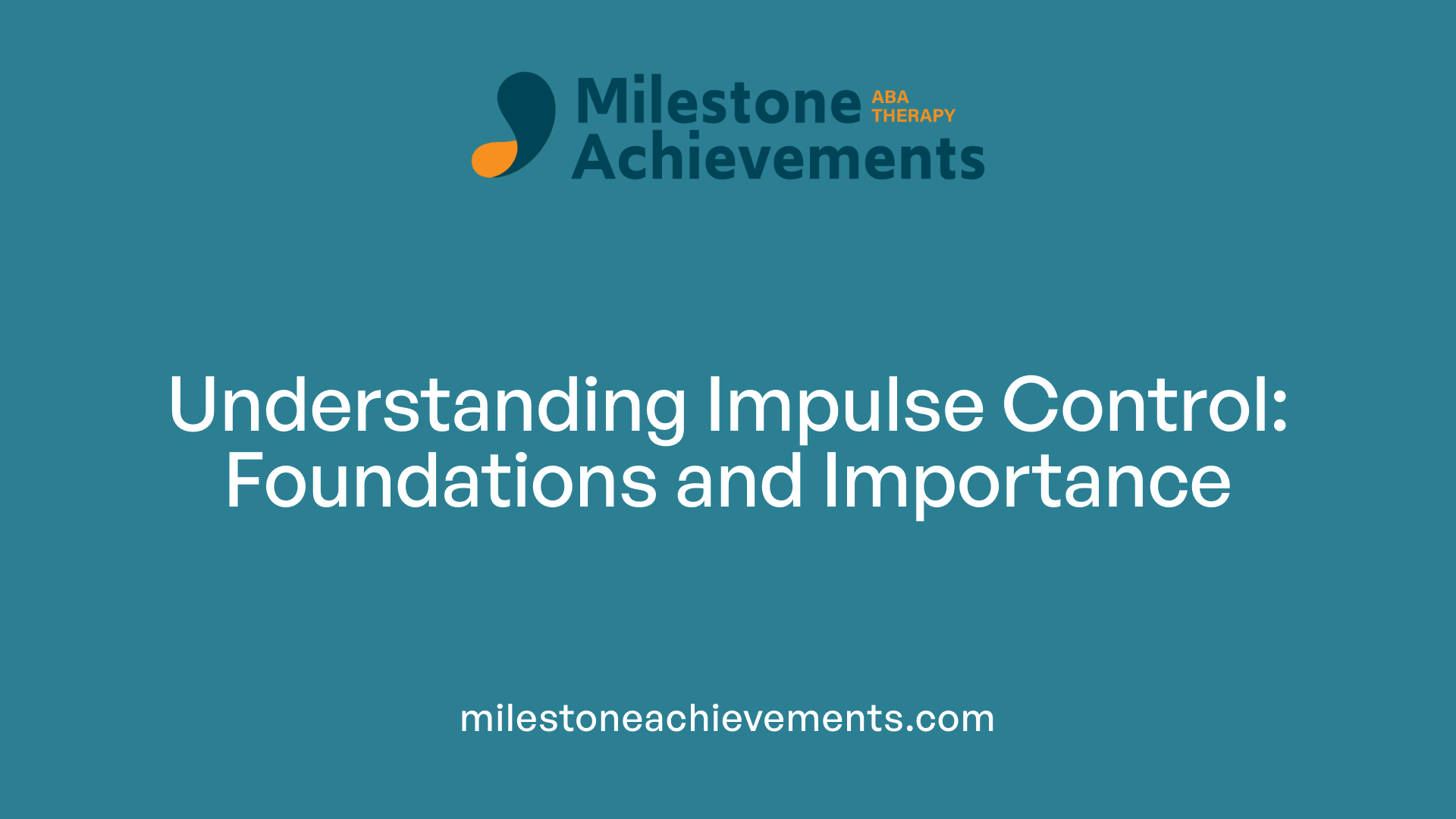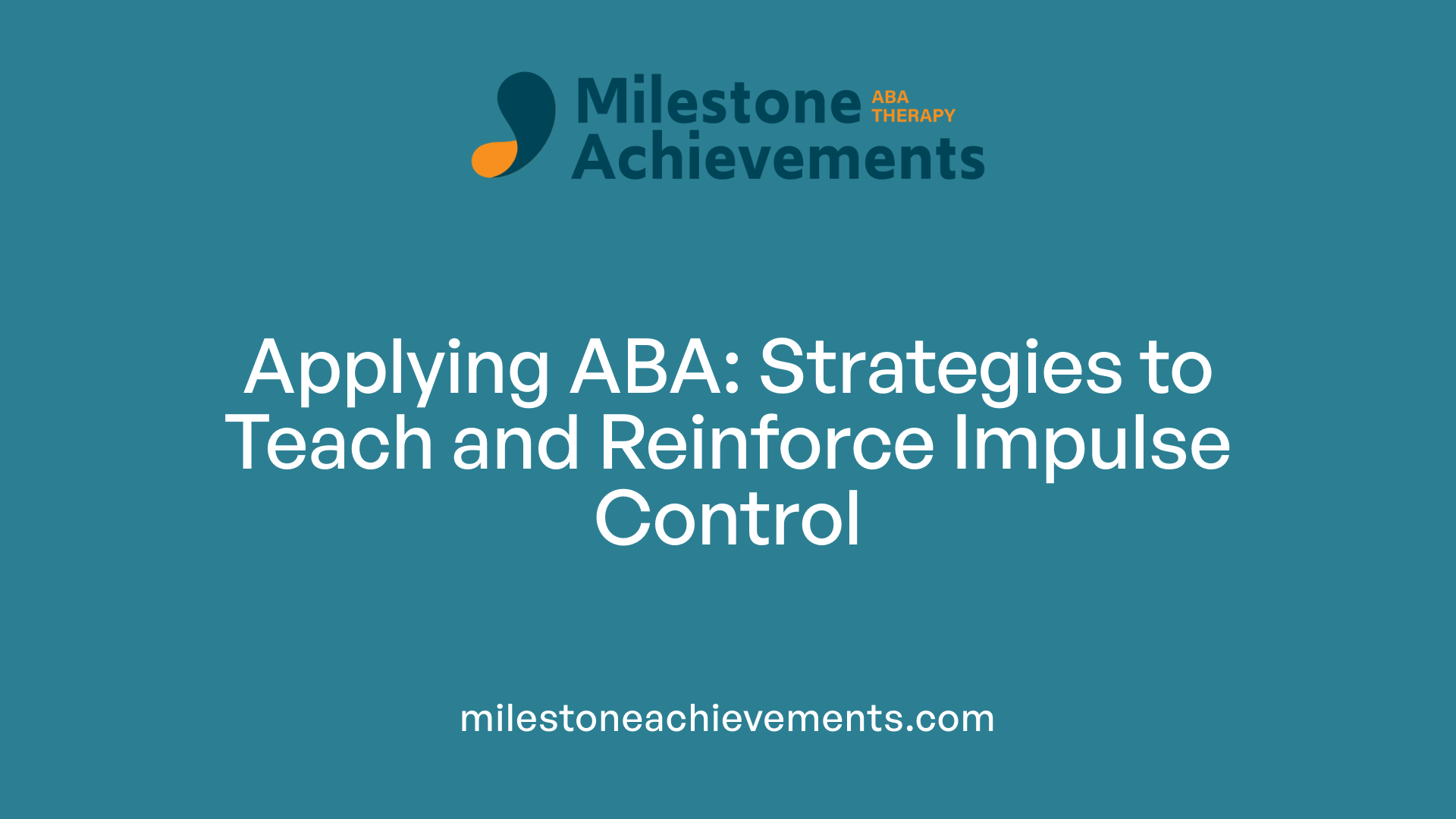
ABA Therapy for Impulse Control
Harnessing Behavioral Science to Improve Impulse Management
Understanding the Role of ABA in Executive Functioning and Self-Regulation
Impulse control is pivotal in emotional regulation and social functioning. For individuals with behavioral challenges, especially children with autism, mastering impulse regulation can lead to better decision-making, enhanced social interactions, and improved overall well-being. Applied Behavior Analysis (ABA) emerges as a cornerstone approach in teaching these vital skills, employing scientifically validated techniques to foster self-control and reduce impulsive behaviors.
The Fundamentals of Impulse Control and Its Significance

What is impulse control and why is it important?
Impulse control is the ability to manage spontaneous urges and delay immediate reactions in favor of more appropriate responses. This self-regulation skill is essential for emotional stability and social interactions.
Having good impulse control helps individuals make thoughtful decisions, sustain focus, and navigate social situations smoothly. It supports positive relationships and enables better academic and professional performance.
How does poor impulse regulation affect behavior?
When impulse control is weak, people often struggle to wait their turn, follow rules, or control their emotions. For children, this can mean frequent outbursts or difficulties in settings like classrooms or playgrounds.
In adults, inadequate impulse regulation can lead to aggressive outbursts, impulsive decision-making, and challenges in social or occupational contexts. These behaviors can have serious repercussions, affecting personal and professional relationships.
Strategies to develop impulse control
Educators, therapists, and caregivers employ various methods to enhance impulse regulation. Visual aids and antecedent logs help individuals recognize triggers and preempt behaviors.
Role-playing scenarios allow practice of appropriate responses to common social situations, while establishing routines and clear rules creates predictable environments conducive to self-control.
Priming and pre-teaching prepare individuals for upcoming activities, reducing anxiety and impulsive reactions. Teaching waiting skills, such as using timers or visual cues, further fosters patience.
Emotion regulation techniques, including deep breathing or mindfulness, equip individuals to manage their feelings before acting on impulses. Reinforcement strategies, such as praise or tokens, reward positive behavior, encouraging ongoing effort.
Behavioral interventions for managing impulsive and aggressive behavior
Applied Behavior Analysis (ABA) is a well-established approach that guides the management of impulsivity, especially in children with developmental disabilities. ABA techniques focus on modifying behavior by limiting reinforcement for maladaptive actions like aggression and promoting socially acceptable communication.
For example, neutral redirection is used to calmly guide individuals towards appropriate behaviors without rewarding aggressive actions with attention. Teaching alternative communication methods helps individuals express needs without resorting to impulsive acts.
In cases of severe impulsivity, reinforcement schedules like token economies—particularly in adult or institutional settings—help motivate individuals to adopt pro-social behaviors.
The role of behavior analysts in impulsivity treatment
Certified behavior analysts (BCBAs) are healthcare professionals trained to develop and implement tailored behavior intervention plans. Their expertise ensures interventions are ethical and effective, based on scientific research.
Behavioral treatments can be instrumental in reducing impulsiveness and aggression associated with diagnoses like conduct disorder, oppositional defiant disorder, or autism spectrum disorder.
Behavior management in autism
Reducing impulsive behaviors in children with autism involves a comprehensive approach.
Behavioral strategies like ABA incorporate reinforcement to shape desired behaviors, while visual schedules and social stories prepare children for daily routines.
Sensory integration therapy can address sensory sensitivities that contribute to impulsivity. Executive functioning training through occupational therapy enhances planning and impulse regulation skills.
Supporting communication and emotional regulation, along with addressing individual triggers, form the foundation for effective management.
Summarizing interventions and their effects
| Strategy | Application | Expected Outcome | Additional Notes |
|---|---|---|---|
| Visual Aids & Logs | Recognize triggers | Better self-awareness | Useful for children & adults |
| Role-play & Pre-teaching | Practice responses | Increased appropriate reactions | Builds confidence |
| Routines & Rules | Create predictability | Reduce anxiety & impulsivity | Effective in structured settings |
| Reinforcement & Feedback | Reward good behavior | Foster self-control | Reinforce positive patterns |
| ABA & Professional Support | Tailored interventions | Reduce aggressive/impulsive acts | Requires trained specialists |
Understanding and applying these strategies can significantly improve impulse regulation, fostering better social functioning and well-being.
ABA Techniques to Teach and Reinforce Impulse Control

How does Applied Behavior Analysis (ABA) help with impulse control?
ABA therapy is widely recognized for its role in managing symptoms related to impulsivity, especially in children with developmental disabilities and behavioral challenges such as ADHD. This approach centers around understanding the factors that trigger impulsive behaviors and systematically applying strategies to modify them.
One of the main methods used in ABA is positive reinforcement. When individuals display controlled, socially acceptable behaviors instead of impulsive actions, caregivers and therapists provide immediate praise or rewards, strengthening these desirable responses. For example, a child who waits patiently for their turn may receive a token or praise as reinforcement.
In addition to reinforcement, ABA employs specific techniques like neutral redirection. This involves calmly guiding a person away from aggressive or impulsive actions without giving attention to the negative behavior. For instance, if a child begins to act out aggressively, a therapist may redirect their attention to a different, acceptable activity, thereby not rewarding the aggression.
Reinforcement strategies including neutral redirection and positive reinforcement
Positive reinforcement constitutes a cornerstone of ABA intervention. Reinforcing appropriate behaviors proactively makes it more likely these behaviors will be repeated. For example, rewarding a child for using words instead of hitting.
Neutral redirection is especially effective in managing aggression and impulsivity. It involves minimally engaging with the undesired behavior, offering no reaction, and instead guiding the individual toward acceptable alternatives. This neutral stance prevents reinforcement of aggressive responses and encourages calmer, socially acceptable behaviors.
For adults, reinforcement strategies include structured systems like token economies. These systems allocate tokens or points for pro-social behaviors, which can later be exchanged for desired rewards. This method is often employed in clinical or criminal justice settings to foster self-control and impulse management.
How do antecedent modifications and signaling delays foster self-control?
Antecedent modifications involve adjusting environmental factors to reduce triggers for impulsive behaviors. For example, establishing clear routines, visual cues, and rules helps set predictable expectations that minimize impulsive reactions.
Signaling delays or signal-based interventions are techniques where caregivers or therapists introduce a pause before responding to a behavior, encouraging the individual to practice self-control. Research shows that signaling delays can help children exercise patience, enabling them to choose larger, delayed rewards over immediate, smaller reinforcers. This delay decreases impulsivity and improves decision-making.
Signaling delays also teach individuals that patience leads to better outcomes, strengthening their ability to delay gratification and manage impulsive urges.
Summarizing the role of ABA in impulsivity management
| Technique | Description | Application Example |
|---|---|---|
| Positive reinforcement | Reward desired behaviors | Praise for waiting patiently |
| Neutral redirection | Calmly guide away from aggression | Redirecting a child to a calm activity |
| Signaling delays | Introduce a pause before response | Waiting for the full question before answering |
| Antecedent modifications | Change environment to reduce triggers | Establishing clear routines |
Behavior analysts, often holding advanced degrees and certifications like BCBA, utilize these evidence-based methods to help individuals develop better impulse control. These interventions are typically tailored to meet individual needs, especially in populations with severe developmental or behavioral challenges.
In summary, ABA techniques—ranging from reinforcement to antecedent modifications—offer powerful tools to reduce impulsivity and aggression. Consistent, structured intervention can significantly improve social functioning, emotional regulation, and overall well-being, especially when applied systematically and ethically.
Implementing ABA Strategies in Various Settings

The importance of consistency across environments
Consistency is vital when implementing ABA strategies for impulse control. Whether at home, school, or community settings, maintaining consistent routines, rules, and reinforcement strategies helps individuals understand expectations and reduces confusion. For example, applying the same methods for teaching waiting skills or emotional regulation across different environments reinforces learning and fosters generalization of appropriate behaviors.
Inconsistent responses from caregivers or educators can undermine progress and lead to confusion or frustration. Clear communication and collaboration among all caregivers are essential to ensure that behavioral strategies are uniformly applied, creating a stable environment that supports behavior change.
Training caregivers and educators in ABA techniques
Educators and caregivers play a crucial role in applying ABA principles. Proper training enables them to recognize triggers for impulsive behavior, implement effective interventions, and reinforce positive behaviors.
Training often includes teaching how to use visual aids, antecedent logs, and reinforcement techniques. For example, caregivers can learn to use neutral redirection by calmly guiding a child to appropriate behaviors instead of reacting emotionally to aggression. Role-play scenarios are also valuable, allowing caregivers to practice intervention strategies in a safe environment.
Equipping caregivers with the skills to systematically teach waiting skills, emotional regulation techniques, and social skills ensures consistency and improves outcomes. Additionally, ongoing supervision and coaching by behavior analysts help maintain proper application of interventions.
Using contingency management systems like token economies in adults
In adult populations, especially in settings like criminal justice or rehabilitation programs, contingency management systems such as token economies are effective. These systems operate by providing tangible rewards or tokens for demonstrating positive, pro-social behaviors, including impulse control.
Tokens can be exchanged for desirable items or privileges, reinforcing behaviors like patience, emotional regulation, and appropriate communication. For example, an individual might earn tokens for abstaining from aggressive outbursts, which they can then redeem for preferred activities or rewards.
Token economies serve to motivate adults by providing immediate reinforcement for desired behaviors and can be tailored to individual needs. They are often integrated into broader treatment plans that include social skills training, emotional regulation strategies, and behavioral coaching.
How do you treat impulsivity in autism?
Treating impulsivity in individuals with autism involves a structured approach that promotes predictability and routine. Visual schedules and clear behavioral expectations help reduce anxiety and impulsive responses. Applying ABA methods assists in identifying specific triggers for impulsive behaviors and developing alternative responses.
Using positive reinforcement to encourage self-regulation is highly effective. For example, rewarding calm behavior or appropriate communication during stressful situations promotes lasting change. Incorporating social skills training and emotional regulation strategies equips individuals with the tools to manage impulses and respond adaptively.
Working with qualified professionals, such as BCBA-certified therapists, ensures that intervention strategies are personalized. These experts can tailor interventions to address unique challenges and progress in a supportive, evidence-based manner.
| Setting | Key Strategies | Focus Area |
|---|---|---|
| Home | Visual schedules, routines | Reduce impulsive reactions through predictability |
| School | Social skills training, clear rules | Promote self-control and appropriate responses |
| Clinical | ABA interventions, reinforcement | Address specific impulsive behaviors |
| Community | Generalization, peer modeling | Extend skills beyond structured environments |
This collaborative and consistent approach across environments ensures the best chances for individuals to develop lasting impulse control skills, ultimately improving their social interactions, decision-making, and overall well-being.
Research and Evidence Supporting ABA for Impulse Management

Can ABA help with impulse control?
Applied Behavior Analysis (ABA) therapy is recognized for its effectiveness in managing symptoms associated with ADHD, particularly impulsivity. By focusing on reinforcing desired behaviors through positive reinforcement, ABA provides children with the tools to better control their impulses and attention.
Scientific studies demonstrating ABA's effectiveness
Numerous studies support the use of ABA in managing impulsivity and aggressive behaviors, especially in children with developmental disabilities. Research shows that behavioral interventions like differential reinforcement can significantly reduce impulsive aggression by reinforcing appropriate responses and discouraging aggressive outlets.
One notable study demonstrated that signaling delays to reinforcement helps children exercise self-control. This approach involves waiting for a larger, delayed reward instead of impulsively choosing a smaller immediate one. Such strategies teach children the value of patience and long-term reward, fostering better impulse control.
Another comprehensive analysis reveals that ABA techniques like neutral redirection—calmly guiding the individual towards acceptable behaviors—effectively manage aggressive outbursts. These techniques, combined with positive reinforcement, promote socially acceptable behavior while decreasing harmful responses.
Correlation between ABA interventions and reductions in aggression and impulsivity
Evidence consistently indicates that ABA-based interventions correlate with reductions in aggression and impulsive behaviors. For example, researchers have documented that interventions targeting impulsive aggression—reinforced by access to food or other immediate reinforcers—can modify the behavior over time.
In adult populations, contingency management systems such as token economies are used to encourage pro-social behaviors. These systems reward individuals for demonstrating desired behaviors, effectively reducing impulsiveness and aggressive tendencies.
Studies on signaling delays and differential reinforcement
Studies focusing on signaling delays have shown that when individuals are taught to wait for a delayed reinforcement, they develop stronger self-control. This approach is especially useful in children with severe developmental disabilities, as it promotes delays in gratification, an essential component of impulse control.
Differential reinforcement techniques—where appropriate behaviors are rewarded while inappropriate behaviors are ignored or not reinforced—have proven successful in decreasing impulsive and aggressive behaviors in various settings. These methods align well with ABA principles and are supported by robust research evidencing their effectiveness.
| Intervention Type | Target Group | Main Technique | Observed Benefits |
|---|---|---|---|
| Signaling Delays | Children with developmental disabilities | Teaching delay of gratification | Improved self-control, greater patience |
| Differential Reinforcement | Children and adults | Reinforcing appropriate responses | Reduced impulsive and aggressive behaviors |
| Token Economies | Adults in correctional settings | Reward-based system | Increased pro-social behavior, less impulsivity |
Final thoughts
Research-backed interventions rooted in ABA offer promising solutions for managing impulse control and aggression. These approaches empower individuals with the skills necessary to navigate social and emotional challenges more effectively, leading to improved overall well-being.
Empowering Caregivers and Professionals with Evidence-Based Strategies
Successfully managing impulsivity, especially in children with autism or behavioral challenges, requires a comprehensive approach rooted in scientifically validated methods. ABA therapy offers specific, customizable techniques—such as reinforcement, antecedent modifications, and neutral redirection—demonstrated to be effective through rigorous research. Educating caregivers, educators, and caregivers on these strategies, alongside continuous professional support from trained behavior analysts, empowers families to foster long-lasting behavioral improvements. Emphasizing ongoing research and ethical practice ensures that interventions remain both effective and respectful of individual needs, ultimately enhancing quality of life and social integration for those with impulse control difficulties.
References
- Curbing Impulses: 7 Strategies for Teaching Impulse Control
- Applied Behavior Analysis in Treating Aggression and Impulse ...
- ABA in the Treatment of Aggression and Impulse Control
- Evaluating self-control and impulsivity in children with severe ...
- 40 Activities to improve impulse control in Autism
- Treatment of Inattention, Overactivity, and Impulsiveness in Autism ...
- Autism, impulsivity and inhibition a review of the literature


Partner with us on your child's journey
Milestone Achievements offers evidence-based ABA therapy to help children with autism reach their full potential. Together we’ll set meaningful goals and celebrate progress every step of the way.
Start ABA Services Today


